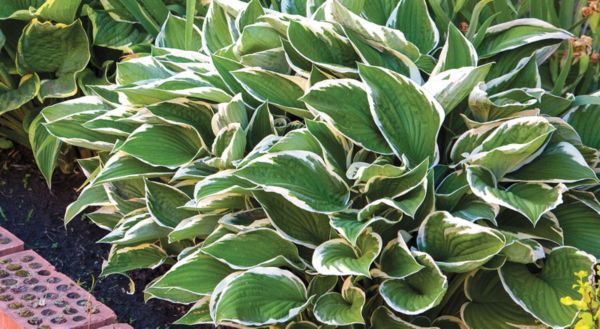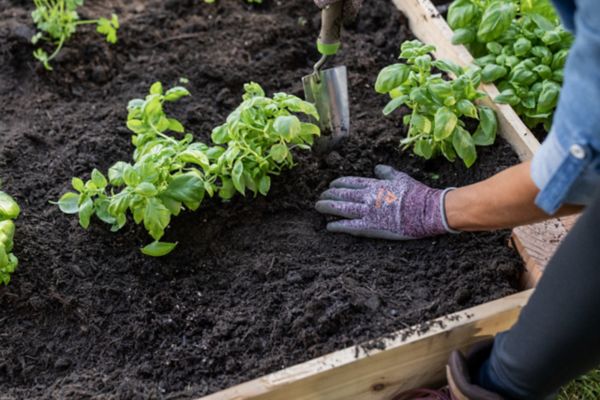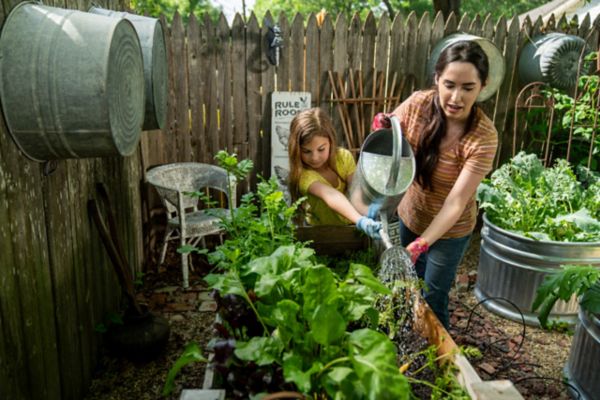How to Grow Sweet Potatoes
Authored by Leah Chester-Davis
This versatile vegetable is also popular on the sweet side. A classic pairing for sweet potatoes is brown sugar and cinnamon. Sweet potatoes are an ingredient in baked goods such as breads, muffins, and cakes, and in some regions of the country are the star ingredient in sweet potato pie, which reigns supreme on many holiday tables.
Sweet potatoes have earned a place on the list of superfoods. Their bright orange flesh is a clue that they are rich in beta carotene and other healthy compounds, including vitamins B6, C, potassium, and fiber. The most common and available varieties have the bright orange flesh but there are varieties with purple and white flesh. Sweet potatoes are a root and not a tuber like Irish potatoes.
This root vegetable is particularly popular during the holiday season but thanks to its flavor and healthful attributes, it deserves a place in your meal repertoire year-round. Sweet potatoes serve up a quick and tasty meal when baked and served with a salad. They can be topped with butter, salt, and pepper or with a variety of savory ingredients depending on your tastes. They are ingredients in soups, stews, and chili. Sweet potatoes are delicious boiled and mashed, as chips or fries, or cubed and roasted as a side dish or as a salad topper.
According to Georgia Extension, sweet potatoes are a healthier alternative to white potatoes, which have a high glycemic index, resulting in a rapid increase in blood sugar. Sweet potatoes are metabolized at a slower rate.
About sweet potatoes
| Botanical name: | Ipomea batatas |
| Common name: | Sweet potato |
| Plant type: | Tender, warm-season annual |
| Size: | Vines 12 inches tall with 3 feet or more spread; tuberous roots around 2 inches in diameter and 6 inches long |
| Sun exposure: | Full sun |
| Soil type: | Well-drained loamy to sandy soils, or heavier soils if amended |
| Soil pH: | 6.0 to 6.5 |
| Hardiness zones: | Best suited for zones 7 to 11 but will grow in cooler zones |
| Average first frost: | Varies by region |
| Average last frost: | Varies by region |
| Container friendly: | Yes, large containers |
| Beginner friendly: | Yes |
Growing
Sweet potatoes are warm-weather plants. Plant them when the soil warms in the spring, well after the danger of frost has passed. They need full sun, preferably 8 to 10 hours per day. They like hot days and warm nights.
They prefer slightly acidic soil, 6.0 to 6.5 pH, that is well-drained. Get your soil tested before planting and follow recommendations. Soil test kits are available from most county Extension offices for free or for a nominal fee. In the absence of a soil test, add plenty of composted organic material. Work the compost into the first 6 inches or so of soil. Sweet potatoes can be grown in large containers or in grow bags. Use a potting mix for vegetables.
Instead of seeds, they are typically grown from “slips,” which are small tuberous roots that have sprouted. Look for disease-free slips at your local garden center or nursery. Or start your own from the previous year’s crop. Another option is to purchase organic sweet potatoes to start slips. Sweet potatoes from the grocery store typically are covered with anti-sprouting agents and may not sprout as readily. If using them, wash them thoroughly before starting your slips.
Sweet potato plants produce about one to two pounds of sweet potatoes. A rule of thumb is to plant five to 10 slips per person to provide enough to store and to eat fresh.
A rule of thumb is to plant five to 10 slips per person.
How to start sweet potato slips at home
If you only need a few slips, Clemson Extension provides these guidelines for starting slips at home:
- Start with healthy, medium-sized sweet potatoes and regular or wide-mouthed jars.
- Insert three or four toothpicks into each root halfway between its two ends.
- Place into a jar, allowing the toothpicks to rest on the rim of the jar. Add water until it covers the bottom half of the sweet potato.
- Water as needed in the coming days to keep the lower half submerged.
- Change the water weekly to reduce bacterial growth.
- Sprouts will appear in about two weeks.
- When the sprouts are about six inches long, pull or twist the sprout free from the sweet potato root.
- Place sprouts in another jar with enough fresh water to cover the bottom ends.
- Over about 10 days they will produce their own roots, which are called slips.
- Plant outside in either garden beds or containers after danger of frost has passed.
If you plan to grow several plants, Utah Extension recommends:
- Place several sweet potato roots one inch apart in a container. A long, flat tub with about 6-inch sides works well.
- Cover with 2 inches of sand or light soil.
- Add another 1 to 2 inches of sand when the shoots begin to appear.
- Keep the soil in the bed moist throughout the sprouting period, but not waterlogged.
- Maintain a soil temperature of 70 to 80 degrees F.
- The slips will be ready in about six weeks. Slips should be 6 to 12 inches long, firm, green, have a healthy root system, and two to four leaves.
Planting
Recommendations for planting vary, depending on soil types. In sandy soils, plant 12 inches apart in rows that are 3 feet apart. Plant at a depth of 3 to 4 inches. In heavy soils, mound the planting row into a ridge about 6 to 9 inches high before planting to provide better drainage, give the roots room to grow, and make it easier to harvest. Bury two to three nodes on the slip.
Water thoroughly after planting.
Use straw as a mulch to suppress weeds and to help keep soil moisture levels even. Apply 1 to 3 inches of mulch around the plants.
As the plant grows, it will need about 1 inch of water per week. Regular, consistent, even watering is important for healthy root development. Sweet potatoes do not like waterlogged soils.
About two to three weeks prior to harvest, stop watering.
Regular, consistent, even watering is important for healthy root development.
Fertilizing
- In the absence of a soil test, Clemson Extension recommends side dressing with 4 pounds of 5-10-10 per 100 feet of row before the vines cover the row. Or use an organic option for vegetables. Follow label directions. Avoid getting fertilizer on the plant. As a guideline for measuring small amounts of fertilizer, Clemson shares this helpful tip: a pint container holds about 1 pound of most fertilizers.
- Avoid over fertilizing, which can result in lots of foliage but few sweet potatoes.
Controlling Pests, Diseases, and Other Problems
Sweet potatoes are relatively pest free. Wire worms and root-knot nematodes are a couple of issues home gardeners may see. Select nematode-resistant varieties and rotate crops in the garden. Avoid planting where you have grown corn, beets, or small grains.
- Dark spots may be scurf, a fungal disease on the skin surface that does not affect the flesh. Scurf can persist for several years in garden soils that receive yearly manure applications, according to Maryland Extension.
- Voles can be a problem. N.C. State Extension recommends setting mousetraps baited with peanut butter.
- To reduce chances of disease, water early in the day to give time for the foliage to dry before nightfall.
- Keep weeds in check.
Harvesting and Storing
Sweet potatoes generally mature in 85 to 100 days. When the roots are eating size, about 2 inches in diameter and 5 to 6 inches in length, it is time to harvest. The foliage typically starts turning slightly yellow when it is harvest time. The best way to know is to dig up a few.
Harvest before frost. A light frost will not hurt the sweet potatoes, but heavy frost can affect their quality. If you cannot harvest before a frost, cut the vines from the crown to minimize damage to the root. Harvest on a dry rather than a wet day. To harvest, cut away the vines. Use a garden fork or spade to loosen and gently lift the roots up from the ground. Make sure to place the fork or spade far enough from the roots to avoid damage.
Handle the sweet potatoes gently to avoid damaging the skin or bruising them. Gently brush away soil. Do not wash before storing.
Spread out the sweet potatoes in a single layer in a dry area such as a porch, garage, or kitchen to allow them to cure for a week to two weeks. The temperature needs to be at least 70 degrees for the curing process to occur. During this period, they begin converting some of the starch to sugars, enhancing their flavor.
Storing
After you have partially cured the sweet potatoes in a covered area for one to two weeks, place in boxes or baskets and store in a cool, dry place such as a basement or location that does not dip below 50 degrees.
Do not refrigerate uncooked sweet potatoes.
In the right conditions, sweet potatoes will last six months or more.
Harvest on a dry rather than a wet day. To harvest, cut away the vines.
Expert Tips
- There are many sweet potato varieties. Among the most popular for home gardens are Beauregard, Centennial, Covington, Jewel, Regal, and Vardaman. Check with your local garden center or Extension office for best varieties for your region.
- Check the maturity dates on the variety you are considering. Shorter maturity varieties may be best options for cooler climates.
- Planting times vary from early May to mid July, depending on your region. Check with your local garden center about the best times to plant in your area. Make sure it is after the frost date and after the soil has warmed.
Frequently asked questions
What causes cracks in my sweet potatoes?
Heavy watering, whether from rainfall or irrigation, two to four weeks before harvest can cause roots to split.
Is a sweet potato and a yam the same thing?
No, while some stores may call sweet potatoes yams, and others use the names interchangeably, they are botanically unrelated. Sweet potatoes are in the morning glory family, Convolvulaceae. Yams are in the Dioscorea genus. They typically grow in Africa and the tropics, are brown and have a bark-like skin, and can grow quite large. When it comes to purchasing canned products that may be labeled as yams, read the label. They likely are sweet potato.





